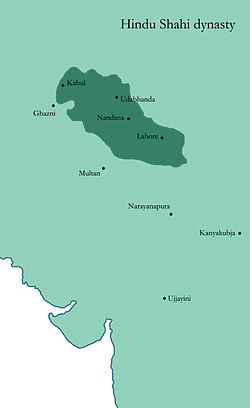Samudra Pal
| Author:Laxman Burdak, IFS (R), Jaipur |
Samudra Pal (b.-d.1010 AD) (समुद्रपाल) was a Burdak (Chauhan) ruler of Dadrewa in Churu district in Rajasthan. Rao Burdakdeo’s elder son Samudra Pal went to Vaihind near Peshawar in Pakistan to extend help to Raja Anand Pal and was killed there in the battle ground fighting with Mahmud of Ghazni. Samudra Pal’s wife Punyani became sati in samvat 1067 (1010 AD) at Sambhar. [1]
Genealogy
Raja Ratansen → Biramrao → Sabal Singh → Alan Singh (922 AD) → Rao Burdakdeo (d.1000 AD) → Samudra Pal (d.1010 AD)
Territory of Samudra Pal
The name 'Samudra Pal' means 'protector of Sea' and this indicates that he was in-charge of area having sea in its terrotory. This area is likely to be Saurashtra region in Gujarat. Than Singh Sinsinwar of Dahra, Kumher, Bharatpur has pointed out that there is a village in Gujarat by the name Burdakdeo. This village was probably founded by Samudrapal. There is need of further research in the matter. This place may be Bodakdev (Hindi: बोडकदेव, Gujarati: બોડકદેવ) locality near Vastrapur Lake in Ahmedabad city of Gujarat.
History
Main article: Burdak
Main article: Burdak Gotra Ka Itihas
As per records of the Bards of the Burdak clan, Rao Burdak Dev went to Lahore to extend help to Raja Jai Pal. He died in war in V.S. 1057 (1000 AD) and his wife Tejal of Shekwal gotra performed sati in Dadrewa. Her chhatri was built on the site of the event at Dadrewa pond in samvat 1058 (1001 AD).
Rao Burdakdeo’s elder son Samudra Pal begot two sons: Nar Pal and Kusum Pal. Smudra Pal went to Vaihind near Peshawar in Pakistan to extend help to Raja Anand Pal and was killed there in the battle ground. Samudra Pal’s wife Punyani became sati in samvat 1067 (1010 AD) at Sambhar. [2]
The Battle of Waihind

It is a matter of research to explore Samudra Pal's death in Waihind (Vaihind, Udabhanda, Udabhandapura). We find that Anandapala was the Indian ruler at the time of Mahmud Gazanavi's sixth invasion of India during 1008-1009 AD in the Vaihind region near Peshawar.[3]
The sixth expedition of Mahmud was led against Anandpal in 1008 AD. He organized a confederacy against the Muslims in which the great Hindu Rajas of Ujjain, Gwalior, Kalinjar, Kannauj, Delhi and Ajmer had joined. Mahmud had never met such a vast army organized by the Hindu confederates. The Khokars from Punjab also joined Hindu army in the struggle against the Muslims. It was a challenge to Mahmud. He met the huge Hindu army near Waihind. The bear-footed and bear-headed Khokars fought very bravely against the Muslims. It was a critical moment for the Muslims. but fortunately the elephant of Anandpal got frightened and fled away from the battle-field. This caused a great confusion and panic among the Hindu soldiers who also ran away from the battle-field. Mahmud won victory.
Waihind is near modern Attock. Gandhāra (गन्धार) is also known as Waihind (ویهیند) in Persian. It was a famous town of ancient India. It is mentioned in the connection with Gazanavi conquests. Mahmud conquered it in 393 AH after conquest of Peshawar. It is the capital of Kandahar and it lies in the Sindh valley. V A Smith in the Early History of India locates the capital named Ohind near Sind River and writes that after the Muslim conquest of Kabul in 256 AH the capital shifted to Ohind which was situated near Sind and was the capital of Hindu Ruling Dynasty. Towns under capital vaihind were Wadhan' Batir, Nawj Lawar' Saman Kuj etc. In the territory of Waihind there was sizable population of Muslims but Hindus were in majority. Both populations had their own kings. [4]
References
- ↑ Records of Rao Bhawani Singh (Mob:09785459386), village Maheshwash, tahsil Phulera, district Jaipur, Rajasthan.
- ↑ Records of Rao Bhawani Singh (Mob:09785459386), village Maheshwash, tahsil Phulera, district Jaipur, Rajasthan.
- ↑ Pratiyogita Darpan Apr 2007 p.1733
- ↑ Muslim kingship in India By Nagendra Kr Singh, p.48
Back to The Rulers

